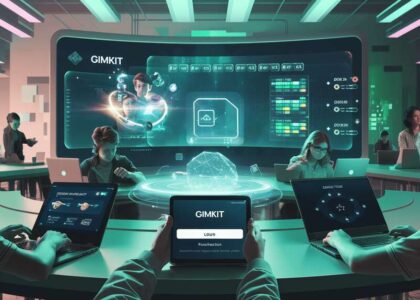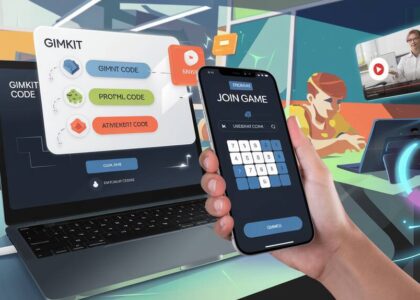Gimkit is a game-based learning platform that turns quizzes into exciting, competitive experiences. Whether you are a teacher, corporate trainer, or someone who loves interactive learning, mastering the role of a Gimkit host can take your live game sessions to the next level. In this guide, we’ll explore the strategies, tools, and techniques to become an expert Gimkit host and create engaging live games that captivate your audience.
Understanding the Role of a Gimkit Host
Being a Gimkit host is more than just running a quiz. It requires a balance of creativity, strategy, and engagement techniques to make sure players stay involved. When hosting a live game, you are responsible for setting the right atmosphere, selecting appropriate game modes, and ensuring a seamless experience for participants.
A successful Gimkit host understands the dynamics of the audience. For instance, a classroom setting might require a different approach than a corporate training session. In a classroom, engagement often comes from competition among students, while in a professional environment, it might be about enjoyably reinforcing learning objectives. Customizing your approach based on the audience ensures maximum participation and engagement.
Additionally, a Gimkit host must manage time effectively. Games should be long enough to be meaningful but not so long that they lose participants’ attention. This means setting up timers, adjusting question difficulty, and being flexible with pacing.
To truly master the role, familiarize yourself with Gimkit’s features, including power-ups, team modes, and customization options. These tools can make the game more interactive and personalized, enhancing the experience for players.
Setting Up an Engaging Gimkit Game
Creating a memorable and engaging Gimkit game starts with thoughtful preparation. Before hosting, consider the topic and objectives. Are you reviewing material for an exam? Reinforcing training content? Or just aiming for a fun learning experience? Answering these questions helps shape the game.
Next, choose the right game mode. Gimkit offers various modes, such as Classic, Team Mode, and Infinity Mode. Classic mode is great for individual competition, while Team Mode encourages collaboration. Infinity Mode can be useful for continuous learning. The mode you choose should align with your learning goals.
Question selection is another crucial aspect. A well-structured Gimkit game includes a mix of question types to keep things interesting. Instead of just multiple-choice, consider including true/false and open-ended questions. This variation helps cater to different learning styles and keeps players engaged.
Power-ups add an exciting element to the game. These allow players to strategize and make the game feel more dynamic. Some power-ups enable players to earn extra points, while others let them sabotage competitors. When used strategically, power-ups enhance the competitive aspect and keep players invested.
Lastly, the game’s pacing matters. Avoid making games too lengthy. Instead, keep rounds manageable so players stay focused. If you’re hosting a longer session, incorporate breaks to prevent fatigue and maintain engagement.
Maximizing Engagement During Live Games
Once the game is set up, the real challenge begins—keeping your audience engaged. A skilled Gimkit host knows how to maintain excitement throughout the session.
One effective strategy is to create a high-energy atmosphere. Your enthusiasm as a host sets the tone for participants. Speak with excitement, encourage friendly competition, and celebrate achievements. A positive, energetic host keeps players motivated and eager to participate.
Another way to maximize engagement is to interact with participants. Ask them about their favorite power-ups, discuss their strategies, or share fun facts related to the quiz topic. Encouraging interaction makes the game more than just answering questions—it becomes a shared experience.
Incorporating storytelling can also enhance engagement. If you’re hosting a history-themed quiz, introduce each section with a short story. For a science-based game, set up a challenge that requires players to “solve a mystery” using their knowledge. By integrating narratives, you make learning feel more immersive.
Furthermore, consider using real-time feedback. Commenting on player progress, acknowledging top scorers, and providing quick tips during the game adds a layer of connection. When participants feel seen and valued, they are more likely to stay engaged and invested in the game.
Must Visit: Gimkit Join Now: 7 Powerful Tips to Enter Games Fast
Troubleshooting Common Hosting Challenges
Even experienced Gimkit hosts face challenges during live games. Knowing how to handle common issues can help ensure a smooth session.
One frequent problem is technical difficulties. Whether it’s connectivity issues, players struggling to join, or slow device performance, having a backup plan is essential. Encourage participants to check their internet connection beforehand, and have alternative devices ready in case of problems.
Another challenge is disengaged players. Some participants might lose interest, especially in longer sessions. To combat this, mix up the game by introducing new question formats, adjusting difficulty levels, or incorporating a surprise element, such as a bonus round or a sudden twist.
Balancing competitiveness can also be tricky. While competition can drive engagement, overly aggressive play can discourage some participants. Set clear expectations about fair play, encourage sportsmanship, and ensure that everyone has a chance to succeed.
Lastly, time management can be difficult. If a game runs too long, attention wanes. If it’s too short, it may not be effective. Gauge the audience’s energy levels and adjust accordingly. Being flexible allows you to make real-time changes for the best experience.
Post-Game Strategies to Enhance Learning
The learning experience doesn’t have to end when the game does. A great Gimkit host knows how to extend the impact beyond the session.
One way to reinforce learning is through discussion. After the game, ask participants about their favorite questions or the most surprising facts they learned. Encouraging reflection helps reinforce key concepts.
Providing a game summary is also beneficial. Gimkit offers reports that show player performance, common mistakes, and areas needing improvement. Reviewing these insights allows for targeted learning interventions.
Another effective strategy is to assign follow-up challenges. For example, students could research a concept they struggled with and present their findings in the next class. In a corporate setting, team members could apply their knowledge to real-world scenarios and share their experiences.
Encouraging replaying of games can also solidify learning. Since Gimkit allows repeated play, challenge participants to beat their previous scores or try different strategies. Making learning an ongoing process keeps engagement levels high even after the session ends.
Leveraging Gamification Strategies to Enhance Engagement
To become an exceptional Gimkit host, incorporating gamification elements beyond the platform’s built-in features can further captivate participants. Gamification taps into motivation by making learning and engagement feel more rewarding and immersive.
One way to enhance engagement is by introducing achievement badges. While Gimkit already provides incentives through power-ups and earnings, you can take it a step further by awarding custom badges for specific accomplishments. For instance, you can create categories like ‘Fastest Answer Streak,’ ‘Strategic Thinker,’ or ‘Comeback Champion.’ This adds a layer of personal achievement that keeps players motivated.
Another strategy is to implement progression systems. Instead of treating each Gimkit session as a standalone event, build an ongoing experience. For example, introduce a leveling-up mechanic where players progress through different stages based on cumulative scores or participation rates. This encourages them to return for future sessions.
Story-driven game sessions can also elevate engagement. A Gimkit host can craft narratives where players ‘unlock’ new parts of a story with each correct answer or game round. Whether it’s solving a mystery, advancing through historical events, or surviving a space mission, storytelling makes the experience feel interactive and purposeful.
Additionally, adding live polls and audience decision-making into the game can foster even more interaction. Giving players choices that impact the flow of the game—such as selecting the next round’s theme—enhances the feeling of involvement.
By incorporating these gamification strategies, a Gimkit host can create an even more immersive and rewarding environment, ensuring that participants stay engaged and eager to play again.
Becoming a Master Gimkit Host
Mastering the art of being a Gimkit host takes practice, creativity, and adaptability. The best hosts continually refine their techniques, experiment with new strategies, and learn from each session. By focusing on engagement, personalization, and continuous improvement, you can create live games that are both educational and entertaining.
With the right approach, Gimkit can transform learning into a dynamic, interactive experience. Whether you’re hosting a classroom review, a corporate training session, or a friendly competition, mastering Gimkit hosting ensures participants walk away with valuable knowledge—and a smile on their faces.
FAQs
1. How can a Gimkit host keep players engaged for longer sessions?
A Gimkit host can maintain engagement by using a variety of strategies, such as mixing up question formats, incorporating power-ups, and using gamification techniques like badges and progress tracking. Additionally, interactive elements such as live discussions and real-time feedback can keep players invested throughout the session.
2. What are the best practices for setting up a smooth Gimkit session?
To ensure a seamless experience, a Gimkit host should test the internet connection, provide clear joining instructions, and pre-load questions to avoid technical delays. Adjusting the game settings for difficulty and duration according to the audience’s skill level also helps keep the experience smooth and enjoyable.
3. How can a Gimkit host handle disengaged or passive players?
If some players seem disengaged, a Gimkit host can introduce team-based challenges, offer incentives like rewards or leaderboards, and encourage active participation through friendly competition. Asking direct questions or involving players in discussions about strategies can also help draw them in.
4. Can a Gimkit host customize games for different learning styles?
Yes, a Gimkit host can tailor the experience by incorporating diverse question types, such as multiple-choice, true/false, and open-ended questions. Additionally, using themes and storytelling elements can cater to both visual and auditory learners, making the game more inclusive.
5. What steps should a Gimkit host take after a game ends?
After the game, a Gimkit host can review performance analytics to identify areas for improvement, encourage discussions about the most challenging questions, and provide follow-up activities. This reinforces learning and prepares participants for future sessions.
For more tips and tricks, visit gimkit.it.com and take your hosting game to the next level!
Creating a Community Around Your Gimkit Games
One way to elevate your role as a Gimkit host is by fostering a sense of community among players. Whether you’re working with students, employees, or general participants, building connections enhances engagement and long-term participation.
Start by creating an ongoing leaderboard. Players love to see their progress over time, and a leaderboard fosters friendly competition. If you’re working with a classroom or a corporate team, consider rewarding top players with small incentives, such as extra credit, badges, or fun titles. This recognition keeps participants motivated.
Encourage collaboration by hosting team-based Gimkit sessions. This not only promotes teamwork but also allows stronger players to support those who may need extra guidance. To maintain balance, switch up team assignments periodically so players get to interact with different people.
Social engagement also plays a key role. Consider creating a dedicated space—such as a classroom discussion board, corporate Slack channel, or private group chat—where participants can discuss strategies, share favorite power-ups, and suggest topics for future games. By involving them in the planning process, you make the experience more interactive and inclusive.
Another effective approach is to host themed game nights. A Gimkit host can introduce special themes based on holidays, industry trends, or pop culture to add a fresh twist to sessions. This keeps things exciting and ensures that players look forward to upcoming games.
Finally, leverage feedback to improve your hosting skills. Ask players what they enjoyed and what could be improved. A responsive host who adapts based on feedback fosters long-term engagement and creates a more dynamic learning environment. With these strategies, you can transform your Gimkit hosting experience into a thriving community of engaged players.





